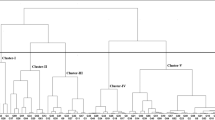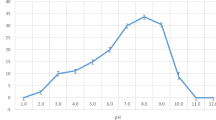Abstract
Allelopathy is one effective solution to reach a healthy life without any pollution. This study was carried out to evaluate the allelopathic potential of 92 Iranian cumin accessions grown under normal conditions and drought stress, according to the sandwich method in the laboratory. In addition, weed infestation of the same cumin accessions was examined in a field by measuring total weed species richness and diversity under normal irrigating conditions. Results indicated that length and fresh weight of radish radicle and hypocotyl are more sensitive than the other germination indices against exuded allelochemicals of cumin seeds. Furthermore, all genotypes showed the average germination percentage to be less than the control samples. They could significantly reduce total species richness and diversity in their surroundings. Weed suppressive percentage of cumin genotypes in the field experiments was positively correlated with inhibition percentage of radicle growth in the laboratory. Water stress increases the allelopathic effects of cumin accessions in laboratory screening. Classification based on principle component method indicated that cumin genotypes were categorized into two clusters in both moisture regimes. Despite having stress factors, only the genotypes 13CGOGK1, 35CSESH1, 65CEAAS, 68CKERF2, 75CYAAR2, and 84CKRTJ2 remained in a group with strong allelopathic activity. According to these results, there is the significant diversity for allelopathic strength in the Iranian cumin germplasm, which can be useful in cumin breeding for weed suppression.
Similar content being viewed by others
References
Ahn JK, Hahn SJ, Kim JT, Khanh TD, Chung IM. 2005. Evaluation of allelopathic potential among rice germplasm for control of Echinochloa crus-galli P. Beauv in the field. Crop Prot. 24: 413–41
Al-Turki AI, Dick WA. 2003. Myrosinase activity in soil. Soil Sci. Soc. Am. J. 67: 139–145
Azizi M, Amini S, Joharchi MR, Oroojalian F, Baghestani Z. 2009. Genetic resources for allelopathic and medicinal plants from traditional Persian experience, Marco Symposium, Mansoon
Bais HP, Park SW, Weir TL, Callaway RM Vivanco JM. 2004. How plants communicate using the underground information superhighway. Trends Plant Sci. 9: 26–32
Chauhan BS. 2012. Weed ecology and weed management strategies for dry-seeded rice in Asia. Weed Technol. 26: 1–13
Einhellig FA. 1996. Interactions involving allelopathy in cropping systems. Agron. J. 88: 886–893
Fay PK, Duke WB. 1977. An assessment of allelopathic potential in Avena germplasm. Weed Sci. 25: 224–228
Fuji Y, Matsuyama M, Hiradate M, Shimozawa H. 2005. Dish pack method: A new bioassay for volatile allelopathy. Proceeding of 4th World Congress on Allelopathy, Wagga Wagga, New South Wales, Australia
Fuji Y, Parvez SS, Parvez MM, Ohmae Y, Iida O. 2003. Screening of 239 medicinal plant species for allelopatic activity using the sandewich method. Weed Biol. Manag. 3: 233–241
Gawronska H, Golisz A. 2006. Allelopathy and biotic stresses. In: MJ Reigosa, N Pedrol, L Gonzalez, eds. Allelopathy: Aphysiological process with ecological implications, Springer, The Netherlands, 211–227
Harper JL. 1977. Population biology of plants. Academic, New York
Inderjit, Duke SO. 2003. Ecophysiological aspects of allelopathy. Planta 217: 529–539
Lockerman RH, Putnam AR. 1979. Evaluation of allelopathic cucumbers (Cucumis sativus) as an aid for weed control. Weed Sci. 27: 54–57
Nandal DPS, Rana P, Kumar A. 1999a. Growth and yield of wheat (Triticum aestivum. L.) under different tree spacings of Dalbergia sissoo based agrisilviculture. Ind. J. Agron. 44: 256–260
Olofsdotter M, Andersen SB. 2004. Improvement of allelopathy in crops for weed management. In: Inderjit, ed. Weed Biol. Management, Kluwer Academic Publisher, 317–328
Olofsdotter M, Jensen LB, Courtois B. 2002. Improving crop competitive ability using allelopathy an example from rice. Plant Breed. 121: 1–9
Olofsdotter M, Navarez K, Moody K. 1995. Allelopathic potential in rice (Oryza sativa L.). Annals of Applied Biology 127: 543–560
Patel DA, Pandya NR. 2013. Allelopathic effect of few medicinal plants on Raphanus sativus L. International J. Res. Plant Sci. 3: 88–93
Pedrol N, Gonzalez L, Reigosa M J. 2006. Allelopathy and abiotic stress. In: MJ Reigosa, N Pedrol, L Gonzalez, eds. Allelopathy: Aphysiological process with ecological implications, Springer, The Netherlands, 171–209
Porheidar Ghafarbi S, Hassannejad S, Lotfi R. 2012. Seed to seed allelopathic effects between wheat and weeds. Int. J. Agric. Crop Sci. 4: 1660–1665
Rice EL. 1984. Allelopathy. London, UK: Academic Press
Sheley RL, Laufenberg SM, Jacobs JS, Borkowski J. 2007. Restoring species richness and diversity in a Russian knapweed (Acroptilon repens) infested riparian plant community using herbicides. Weed Sci. 55: 311–318
Tongma S, Kobayashi K, Usui K. 2001. Allelopathic activity of Mexican sunflower (Tithonia diversifolia) in soil under natural field conditions and different moisture conditions. Weed Biol. Manag. 1: 115–119
Worthington M, Reberg-Horton C. 2013. Breeding cereal crops for enhanced weed suppression: optimizing allelopathy and competitive ability. J. Chem. Ecol. 39: 213–231
Xu M, Galhano R, Wiemann P, Bueno E, Tiernan M, Wu W, Chung IM, Gershenzon J, Tudzynski B, Sesma A, et al. 2012. Genetic evidence for natural product-mediated plant-plant allelopathy in rice (Oryza sativa). New Phytol. 193: 570–575
Author information
Authors and Affiliations
Corresponding author
Rights and permissions
About this article
Cite this article
Ghafari, Z., Karimmojeni, H., Majidi, M.M. et al. Assessment of the Allelopathic Potential of Cumin Accessions in Different Soil Water Potential. J. Crop Sci. Biotechnol. 21, 249–260 (2018). https://doi.org/10.1007/s12892-017-0107-0
Received:
Revised:
Accepted:
Published:
Issue Date:
DOI: https://doi.org/10.1007/s12892-017-0107-0




